Thanks to the pre-pandemic tourism boom, much of Taiwan’s tourism infrastructure has been updated in the past decade. Among those who have especially benefited are people who need wheelchairs to get about, and those who struggle when faced with obstacles that the able-bodied can step over or step around.
Not every brand-new facility is perfect, but the concept of “universal design” (ensuring that buildings and other environments are accessible to everyone, regardless of age, disability or other factors) is slowly entering the mainstream.
This article looks at three tourist destinations where the needs of the infirm and wheelchair-bound have been taken into account, so they can enjoy a true outdoors experience.
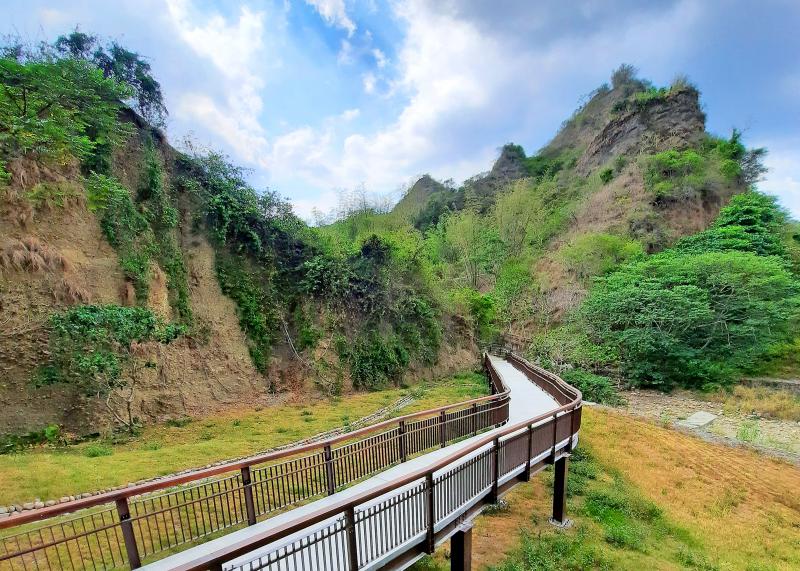
Photo: Steven Crook
CINGJING SKYWALK
The history of Cingjing Farm (清境農場) is well known. Established by the Chinese Nationalist Party (KMT) regime so anti-communist guerillas evacuated from Southeast Asia in 1961 could be resettled, within a generation it had morphed into a magnet for domestic tourists. It remains the only place in Taiwan where sheep have been successfully raised.
Since 2017, sightseers have had another reason to visit the Cingjing area, which on a good day is just 90 minutes’ drive from central Taichung.
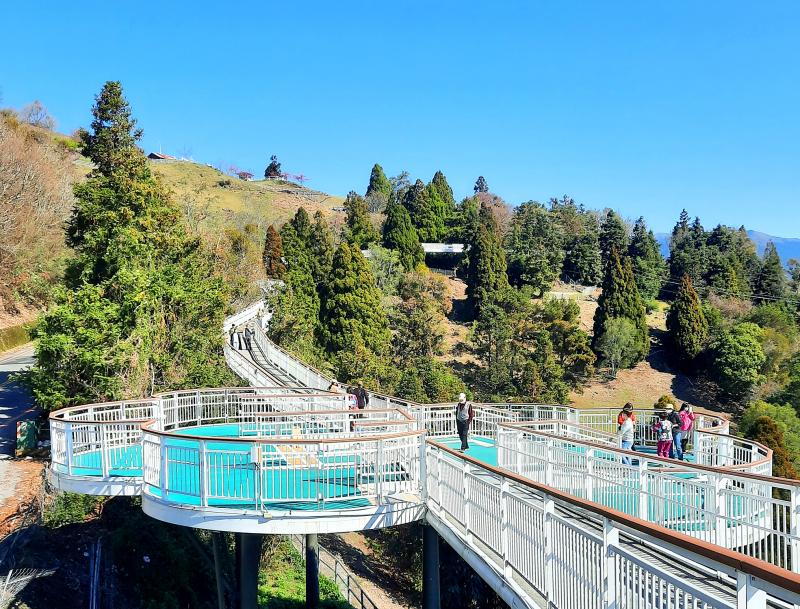
Photo: Steven Crook
Cingjing Skywalk (清境高空步道), a 1.6km-long elevated path with superb views of the nearby Central Mountain Range (中央山脈), runs parallel to part of Provincial Highway 14A (14甲). There’s a sprawl of eateries and shops around its southern end. Its northern terminus has an entrance to the pastureland known as Green Green Grassland (青青草原).
Many visitors go from north to south. If you want to catch one of the farm’s sheep-shearing shows, it makes sense to take in the morning performance, then saunter leisurely along the skywalk until lunchtime.
If there’s a wheelchair user in your group, moving in this direction also means the gradient will be in your favor. This isn’t to say that fit people will find walking south to north at all difficult — the incline is gentle throughout.
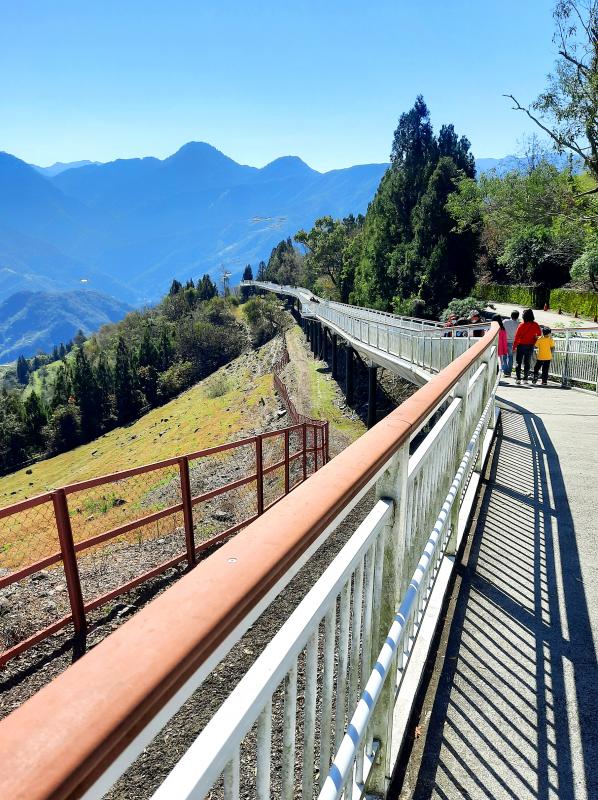
Photo: Steven Crook
The path is 2.5m wide, more than enough for wheelchairs and baby strollers to pass and turn without difficulty. The main handrails are quite high, so people don’t topple off the walkway when taking selfies. For the sake of wheelchair users and infants, there are additional lower handrails on both sides.
The skywalk’s viewing platforms offer plenty of space, as well as breathtaking perspectives. The peaks of Cilai Mountain (奇萊山) and Nenggao Mountain (能高山) are usually visible.
Standard admission to the skywalk costs NT$50. For residents of Nantou County and children who’ve yet to enter elementary school, it’s NT$30. Disabled people (and one able-bodied companion for each handicapped individual) pay NT$10, as do senior citizens.
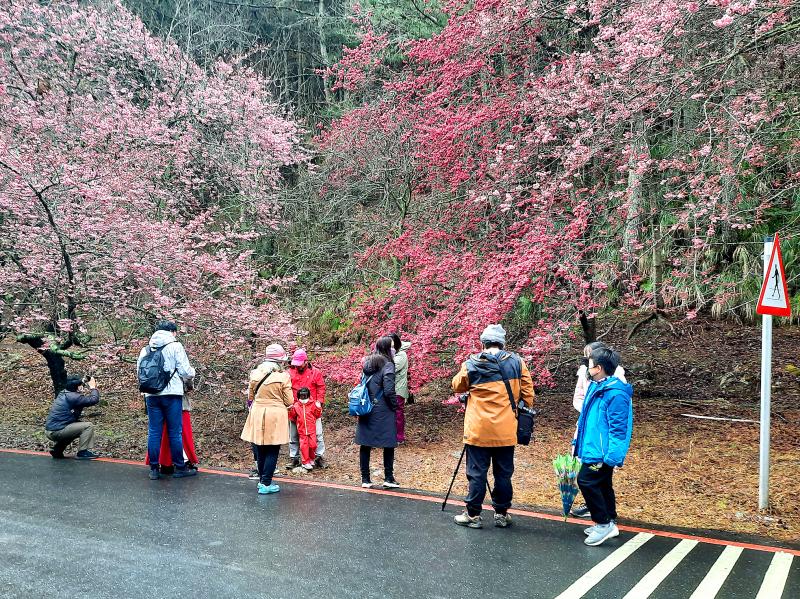
Photo: Steven Crook
The authorities limit visitor numbers to 4,000 per day, with 3,400 tickets being available for online reservation in advance. The skywalk is open from 8am to 4:30pm each day.
There’s no bathroom along the path. If you need to answer the call of nature, or want to get something to eat, you can leave the skywalk and return the same day without buying an additional ticket; just get your hand stamped as you leave. If you wish to leave the skywalk at the northernmost entrance/exit, you’ll need to buy a ticket for Green Green Grassland. (General admission to the grassland is NT$200).
The skywalk is around 1,750m above sea level and exposed to the elements, so be prepared for both cold winds and strong sunshine.
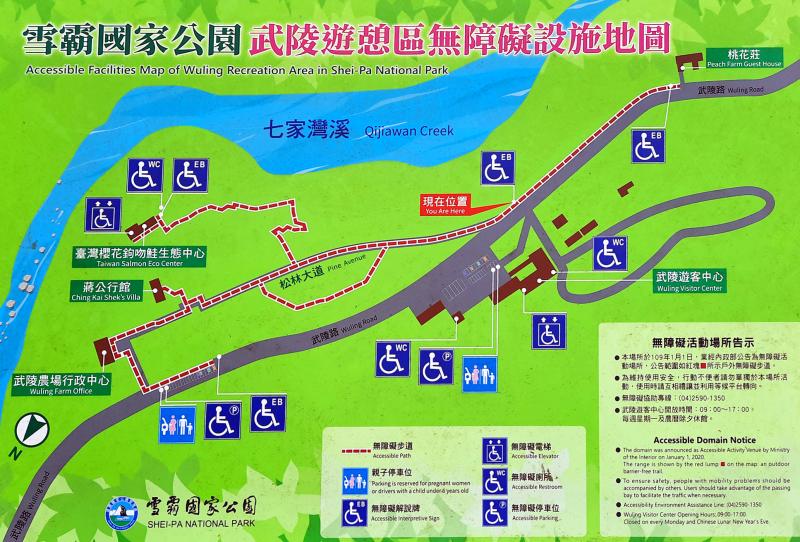
Photo: Steven Crook
WULING FARM
Considering how many different government agencies have overlapping responsibilities for this valley deep in the mountains of Taichung, Wuling Farm (武陵農場) runs like a well-oiled machine.
Like Cingjing Farm, Wuling Farm was carved out of the wilderness to provide employment for demobilized military personnel. The Veterans Affairs Council (國軍退除役官兵輔導委員會 or 退輔會) continues to play a central role in its management, while Shei-Pa National Park (雪霸國家公園) is charged with protecting the area’s ecosystems. Because much of the farm’s 700 hectares are being afforested, the Forestry Bureau (林務局) is also involved.
During the cherry and plum-blossom season, the farm attracts so many sightseers that visitor numbers are capped, and most private vehicles are kept out.
Minimizing the number of cars inside the farm is important, because many tourists — be they users of mobility aids or blessed with two good legs — get from one scenic spot to another via the main road.
It’s not practical for wheelchair-bound visitors to make their way to Taoshan Waterfall (桃山瀑布). However, with a bit of help they can follow the trail a short distance to Wuling Suspension Bridge (武陵吊橋) and look down at Cijiawan Creek (七家灣溪).
This waterway isn’t just a beautiful high-altitude stream. It’s also the main habitat of the beleaguered Formosan landlocked salmon. This fish never ventures near the sea, because adult salmon sicken in waters warmer than 17 degrees Celsius, and their eggs don’t hatch in temperatures above 12 degrees Celsius.
The creek is pristine, yet you shouldn’t expect to see any salmon from the bridge. Few of them grow more than 40cm in length, and their mottled gray appearance helps them blend in with the gravelly streambed.
Fortunately, you’re almost guaranteed to see a few swimming in the manmade pools near the Taiwan Salmon Eco Center (台灣櫻花鉤吻鮭生態中心). The center has both an accessible elevator and a barrier-free bathroom.
General admission: NT$160. There are also parking charges.
18 ARHATS MOUNTAIN
Kaohsiung’s Liouguei District (六龜) is cut into halves by the Laonong River (荖濃溪). On the western side of this waterway, there’s a range of steep hillocks known as 18 Arhats Mountain (十八羅漢山), in honor of the Buddha’s original followers.
The number is poetic license. There are actually more than 40 cone-shaped hills, and until well into the 20th century they formed a barrier between Liouguei and the outside world.
To improve transportation links, the Japanese colonial authorities cut six tunnels between 210m and 42m in length through the hills. Once Provincial Highway 27A (27甲) was built, these tunnels were more or less forgotten about.
In recent years, they’ve been reopened to the public, and a short and flat yet very pleasant path has been laid so everyone can enjoy the area’s appealing scenery.
There are no admission or parking charges.
Steven Crook has been writing about travel, culture and business in Taiwan since 1996. He is the author of Taiwan: The Bradt Travel Guide and co-author of A Culinary History of Taipei: Beyond Pork and Ponlai.

June 9 to June 15 A photo of two men riding trendy high-wheel Penny-Farthing bicycles past a Qing Dynasty gate aptly captures the essence of Taipei in 1897 — a newly colonized city on the cusp of great change. The Japanese began making significant modifications to the cityscape in 1899, tearing down Qing-era structures, widening boulevards and installing Western-style infrastructure and buildings. The photographer, Minosuke Imamura, only spent a year in Taiwan as a cartographer for the governor-general’s office, but he left behind a treasure trove of 130 images showing life at the onset of Japanese rule, spanning July 1897 to

One of the most important gripes that Taiwanese have about the Democratic Progressive Party (DPP) is that it has failed to deliver concretely on higher wages, housing prices and other bread-and-butter issues. The parallel complaint is that the DPP cares only about glamor issues, such as removing markers of Chinese Nationalist Party (KMT) colonialism by renaming them, or what the KMT codes as “de-Sinification.” Once again, as a critical election looms, the DPP is presenting evidence for that charge. The KMT was quick to jump on the recent proposal of the Ministry of the Interior (MOI) to rename roads that symbolize

On the evening of June 1, Control Yuan Secretary-General Lee Chun-yi (李俊俋) apologized and resigned in disgrace. His crime was instructing his driver to use a Control Yuan vehicle to transport his dog to a pet grooming salon. The Control Yuan is the government branch that investigates, audits and impeaches government officials for, among other things, misuse of government funds, so his misuse of a government vehicle was highly inappropriate. If this story were told to anyone living in the golden era of swaggering gangsters, flashy nouveau riche businessmen, and corrupt “black gold” politics of the 1980s and 1990s, they would have laughed.

In an interview posted online by United Daily News (UDN) on May 26, current Chinese Nationalist Party (KMT) Chairman Eric Chu (朱立倫) was asked about Taichung Mayor Lu Shiow-yen (盧秀燕) replacing him as party chair. Though not yet officially running, by the customs of Taiwan politics, Lu has been signalling she is both running for party chair and to be the party’s 2028 presidential candidate. She told an international media outlet that she was considering a run. She also gave a speech in Keelung on national priorities and foreign affairs. For details, see the May 23 edition of this column,